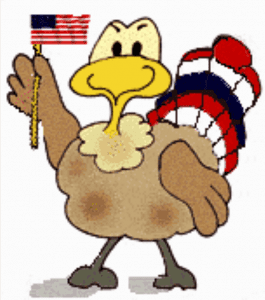Americans in the 21st century, no matter how diverse our lives may be, share one common bond… November means THANKSGIVING. It’s a tradition that pre-dates the United States by over one-hundred and sixty years. Unlike many other holidays, people of all faiths, races, and ethnicities can celebrate together. It’s this element of Thanksgiving that is perhaps why Americans like it so much … a tried and true holiday melting pot.
But even Thanksgiving itself hasn’t sailed through the years without political controversy. The holiday has been observed since 1621, but this observance wasn’t always uniform. Different cities and towns would hold Thanksgiving feast in coordination with community tradition, or (most important) high yield from the Fall Harvest. So throughout the seventeenth, eighteenth and early nineteenth centuries, celebrations were done in a piecemeal fashion across the country.
That changed in 1863. As the nation was at the height of Civil War, President Abraham Lincoln declared that Thanksgiving should be celebrated on the last Thursday of November. He essentially codified the date and that’s where it remained. One can see the logic behind this… It gave the war-torn nation cause to cease fighting, and do something together. Many Southerners, though they thought of themselves as separate from the Union at the time, still got word of Lincoln’s proclamation. And thanks to copious family ties, celebrated on that day with their Union brethren. Thanks, indeed.
So there you have it, tradition established. Now we know when Americans will celebrate a coordinated Thanksgiving holiday. Or maybe not?
Most people are aware that the Christmas shopping season begins the day after Thanksgiving (what we’ve now come to know as “Black Friday”). And most years, Thanksgiving will naturally fall on the 4th Thursday of November, because there are typically only 4 Thursdays in November. Unless you’re in an odd year like 2012, where we end up with 5 Thursdays this month. The choice between the 4th or 5th Thursday to have a holiday might go under the radar for most, but it’s NEVER a neglected fact to our nation’s retailers, because where this holiday falls on the calendar determines how many profitable sales days they will have for the year.
Enter President Franklin D. Roosevelt, newly elected into office in 1933. This was yet another odd year that had 5 Thursdays in November, and business leaders, fearing a woefully-short shopping season, asked the President to move Thanksgiving up from November 30th to November 23rd. He didn’t move the date, and they had to make due.
After six years of economic hardship, another opportunity came in 1939, and this time the President listened. He proclaimed Thanksgiving to be the 4th Thursday of November, thus moving it up by one week as business leaders had asked. From the FDR Presidential Library, here’s what happened as a result:
Changing the date of Thanksgiving seemed harmless enough, but in actuality proved quite controversial. It was so upsetting that thousands of letters poured into the White House once President Roosevelt announced the date change. Some retailers were pleased because they hoped the extra week of Christmas shopping would increase profits, but smaller businesses complained they would lose business to larger stores. Other companies that depended on Thanksgiving as the last Thursday of November lost money; calendar makers were the worst hit because they printed calendars years in advance and FDR made their calendars out of date for the next two years. Schools were also disrupted by Roosevelt’s decision; most schools had already scheduled vacations and annual Thanksgiving Day football games by the time they learned of Thanksgiving’s new date and had to decide whether or not to reschedule everything. Moreover, many Americans were angry that Roosevelt tried to alter such a long-standing tradition and American values just to help businesses make more money.*
As opposition grew, some states took matters into their own hands and defied the Presidential Proclamation. Some governors declared November 30th as Thanksgiving. And so, depending upon where one lived, Thanksgiving was celebrated on the 23rd and the 30th. This was worse than changing the date in the first place because families that lived in states such as New York did not have the same day off as family members in states such as Connecticut! Family and friends were unable to celebrate the holiday together.
Franklin Roosevelt observed Thanksgiving on the second to last Thursday of November for two more years, but the amount of public outrage prompted Congress to pass a law on December 26, 1941, ensuring that all Americans would celebrate a unified Thanksgiving on the fourth Thursday of November every year.
Reverend Jim Bankston from St. Paul’s United Methodist Church in Houston had even further memories. “Well into the 1950s when I was young, the confusion around when to celebrate Thanksgiving persisted.” Just goes to show that even our most revered traditions aren’t unblemished by controversy. As 21st century people, perhaps the best lesson we can take from this is that no matter how great our differences may seem on the outside, we are still more alike than different. After a tough election year, let’s remember that we all have something to be thankful for this holiday season.
Happy Thanksgiving to one and all.

